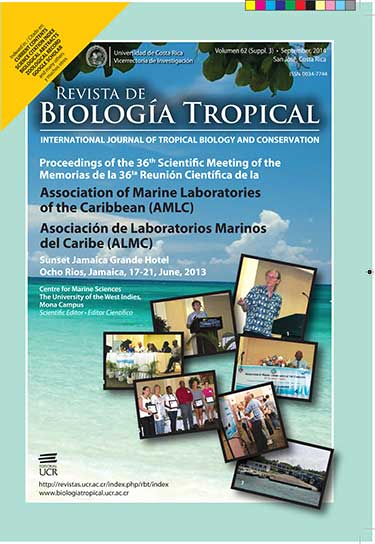Abstract
The marine park of Xel-Há has a population of Strombus gigas which breeds in the area. We determined the relationship between reproductive activity, conch density and environmental parameters. Samples were collected from February to December 2012, using the transect method, at four sites of Marine Park Xel-Ha, Quintana Roo, Mexico. Sediment samples were analyzed and classified using Folk & Ward’s method. Temperature, salinity and dissolved oxygen were also recorded. Density had a small correlation with sediment (Pearson r=0.29 with very coarse and r=0.26 with coarse sand), while mating and spawning had a correlation of r=0.54 and 0.62 with medium sand, respectively. Density was high in the four sites and was not associated with mating and spawning (r=0.08 and 0.03, respectively). For reproduction, S. gigas requires specific substrate conditions (sandy effect) and not just a density of 56 Conch Ha–1 (Allee effect). Rev. Biol. Trop. 62 (Suppl. 3): 207-213. Epub 2014 September 01.
References
Aldana-Aranda, D., & Frenkiel, L. (2007). Lip thickness of Strombus gigas versus maturity: a management measure. Proceedings of the Gulf and Caribbean Fisheries Institute, 58, 431-442.
Aldana-Aranda, D. (2006). Overview of reproductive patterns of the queen conch Strombus gigas from different reef systems in the Caribbean. Proceedings of the Gulf and Caribbean Fisheries Institute, 57, 771-790.
Aldana-Aranda, D., Baqueiro-Cárdenas, E., & Manzanilla-Naim, S. (2003a). Mexican marine parks as a fishery management tool for the queen conch Strombus gigas. In Aldana-Aranda, D. (ed.). El caracol rosa Strombus gigas: conocimiento integral para su manejo sustentable en el Caribe. México: CYTED-Press.
Aldana Aranda, D., Cardenas, E.B., Morales, I.M., Ochoa, R.I., & Brule, T. (2003b). Reproductive patterns of Strombus gigas from Alacranes Reef versus Chinchorro Bank of Mexico. Proceedings of the Gulf and Caribbean Fisheries Institute, 54, 202-225.
Aldana-Aranda, D., Cardenas, E. B., Morales, I. M., Ochoa, R. I., Brule, T., & Baez, R. I. O. (2003c). Gonad behavior during peak reproduction period of Strombus gigas from Banco Chinchorro. Bulletin of Marine Science, 73(1), 241-248.
Aldana-Aranda, D., Sánchez-Crespo, M., Reynaga-Álvarez, P., Patiño-Suarez, V., George-Zamora, A., & Baqueiro-Cárdenas, E.R. (2003d). Crecimiento y temporada reproductiva del caracol rosa Strombus gigas en el Parque Xel-Ha, Mexico. Proceedings of the Gulf and Caribbean Fisheries Institute, 56, 741-754.
Aldana-Aranda, D., Sánchez-Crespo, M., Patino-Suarez, V., George-Zamora, A., Baqueiro-Cárdenas, E., Carillo, E., & Pérez, S. (2003e). Abundancia, frecuencia de tallas y distribucion especial del caracol Strombus gigas en el Parque Xel-Ha, Mexico. In Aldana-Aranda, D. (Ed.). El caracol rosa Strombus gigas: conocimiento integral para su manejo sustentable en el Caribe. México: CYTED-Press
Bissada-Gooding, C. E., & Oxeford, H. A. (2010). Estimating Home Range and Density of a Queen Conch Aggregation using Acoustic Telemetry and Conventional Tagging. Proceedings of the Gulf and Caribbean Fisheries Institute, 62, 384-389.
Brito Manzano, N., Aldana Aranda, D., de la Cruz Lázaro, E., & Estrada Botello, M. A. (2006). Organogénesis larvaria de Strombus gigas (Mesogastropoda: Strombidae) en el Arrecife Alacranes durante el período máximo de su época reproductiva. Redalyc, Universidad y Ciencia, 22(1), 75-82.
Brownell, W. N., & Stevely, J. M. (1981). The biology, fisheries and management of the Queen conch Strombus gigas. Marine Fisheries Review, US Department of Commerce, 43(7), 1-12.
Castro-Gonzalez, E. R., Frenkiel, L., Baqueiro-Cardenas, E., & Aldana-Aranda, D. (2007). Atypical reproductive cycle of the queen conch Strombus gigas (Mollusca: gastropoda). Proceedings of the Gulf and Caribbean Fisheries Institute, 58, 443-450.
de Jesús Navarrete, A. (1999). Distribución y abundancia de larvas velígeras de Strombus gigas en Banco Chinchorro Quintana Roo, México. Tesis doctoral, Centro de Investigación y de Estudios Avanzados del Instituto Politécnico Nacional, México.
de Jesús-Navarrete, A., & Valencia-Beltrán, V. (2003). Abundance of Strombus gigas zero-year class juveniles at Banco Chinchorro Biosphere Reserve, Quintana Roo, Mexico. Bulletin of Marine Science, 73, 232-240.
de Jesús-Navarrete, A. (2001). Crecimiento del caracolStrombus gigas (Gastropoda: Strombidae) en cuatroambientes de Quintana Roo, México. Revista de Biologia Tropical, 49, 85-91.
Delgado, G. A., Bartels, C. T., Glazer, R. A., Brown-Petersen, N. J., & McCarthy, K. J. (2004). Translocation as a strategy to rehabilitate the queen conch (Strombus gigas) population in the Florida Keys. Fishery Bulletin, (2), 278-288.
Folk R. L., & Ward, W. C. (1957). Brazos River bar: a study in the significance of grain size parameters. Journal of Sedimentary Petrology, 27, 3-26.
Gascoigne J. C., & Lipcius, R. N. (2004). Allee effects driven by predation. Journal of Applied Ecology, 41, 801-810.
Peel, J. R., & Aldana-Aranda, D. (2012). Growth and population assessment of the queen conch Strombus gigas (Mesogastropoda: Strombidae) by capture mark-recapture sampling in a natural protected area of the Mexican Caribbean. Revista de Biologia Tropical, 60(1), 127-137,
Pérez-Pérez, M., & Aldana-Aranda, D. (2000). Distribución abundancia, densidad y morfometría de Strombus gigas (Mesogastrópoda: Strombidae) en el arrecife Alacranes, Yucatán, México. Revista de Biologia Tropical, 48, 51-57
Randall, J. E. (1964). Contributions to the biology of the queen conch, Strombus gigas. Bulletin of Marine Science, 14(2), 246-295.
Stoner, A. W., & Ray-Culp, M. (2000). Evidence for Allee effects in an over-harvested marine gastropod: density-dependent mating and egg production. Marine Ecology Progress Series, 202, 297-302.
Stoner, A. W., Sandt, V. J., & Boidron-Metairon, I. F. (1992). Seasonality of reprodutucive activity and abundance of veligers in queen conch, Strombus gigas. Fishery Bulletin, 90, 161-170.
Fig. 1. Study area, Xel-Ha Park in the Mexican Caribbean, indicating four samples sites: Bocana, Centro, Brazo Norte and Cueva.
##plugins.facebook.comentarios##

This work is licensed under a Creative Commons Attribution 4.0 International License.
Copyright (c) 2014 Revista de Biología Tropical






